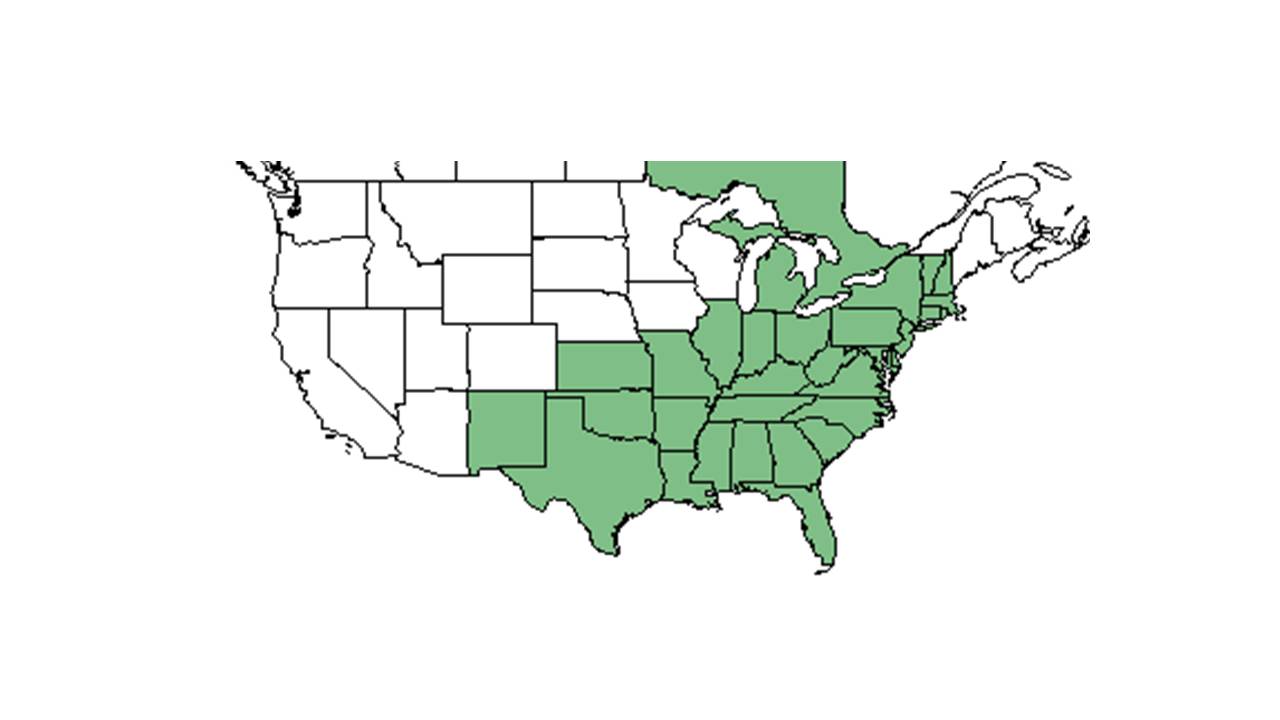Galium pilosum
| Galium pilosum | |
|---|---|

| |
| Photo taken by Kevin Robertson | |
| Scientific classification | |
| Kingdom: | Plantae |
| Division: | Magnoliophyta - Flowering plants |
| Class: | Magnoliopsida – Dicotyledons |
| Order: | Rubiales |
| Family: | Rubiaceae |
| Genus: | Galium |
| Species: | G. pilosum |
| Binomial name | |
| Galium pilosum Aiton | |

| |
| Natural range of Galium pilosum from USDA NRCS Plants Database. | |
Common name: Hairy bedstraw
Contents
Taxonomic notes
Synonyms: Galium pilosum Aiton var. pilosum; G. pilosum Aiton var. puncticulosum (Michaux) Torrey & A. Gray
Description
Generally, Galium genus are "perennial or annual herbs, the stems weak, often scabrous; the roots often red or orange. Leaves whorled, entire. Flowers in simple or profusely branched cymes or the inflorescence reduced and the flowers 1-several and axillary; sepals usually obsolete, corolla rotate, 3-5 lobed; stamens 3-5. Fruit dry or sometimes fleshy, indehiscent, subglobose or reniform, or if the two carpels both develop and stay together the fruit broader than long." [1]
Specifically, for this species, G. pilosum are "perennial, the stems erect or ascending, unbranched except in the elongate inforescence, 3-8 dm tall, smooth, pilose. Leaves 4 per node, elliptic to weakly ovate, 1-2.5 cm long, 6-12 mm wide, mucronate, pilose-hispid, glandular-punctate beneath. Corolla white, greenish or shaded with maroon. Fruit dry, brown, or black, bristly, 2-3 mm long, 3-4 mm broad." [1]
Distribution
Ecology
Habitat
This species has been found in wet flatwoods, mixed hardwoods, longleaf pine-wiregrass savannas, coastal and cabbage palm hammocks, river floodplains, rich woodlands, grassy and shrubby thickets, coastal dunes, sandy ridges, and near ponds. They are found to grow in partial shade and under open canopies of pinewoods in well drained moist sandy soils, drying loamy sands, limestone outcrops, or dry loamy sands during drought. They also have been observed growing in disturbed areas such as picnic areas, along roadsides, in powerline corridors, along trails, on sand pine plantations,in borrow pits, on bulldozed areas, and in "battered" limestone glades.[2] Associated species includes Smallanthus, Schisandra, Collinsonia, Nyssa, Ulmus, Pinus, Quercus, Carya, Aristida stricta, Acer, Magnolia, Ilex, Aesculus, Pinus elliottii, Giallardia pulchella, and Quercus laevis. Also includes cabbage palm.[2]
Phenology
G. pilosum has been observed flowering in March, from May through August and October through November with peak inflorescence in June.[3][2] It has been observed fruiting from June through November.[2]
Seed dispersal
This species is thought to be dispersed by translocation on animal fur or feathers. [4]
Fire ecology
This species can be found in annually burned pinelands.[2] It has been observed flowering in July following a March prescribed burn in research plots in a longleaf pine-wiregrass native community in southern Georgia.[5]
Conservation and management
Cultivation and restoration
Photo Gallery
References and notes
- ↑ 1.0 1.1 Radford, Albert E., Harry E. Ahles, and C. Ritchie Bell. Manual of the Vascular Flora of the Carolinas. 1964, 1968. The University of North Carolina Press. 984-6. Print.
- ↑ 2.0 2.1 2.2 2.3 2.4 Florida State University Robert K. Godfrey Herbarium database. URL: http://herbarium.bio.fsu.edu. Last accessed: June 2014. Collectors: Loran C. Anderson, R.K. Godfrey, Robert Kral, Cecil R Slaughter, Gil Nelson, W. H. Lewis, R. A. Norris, R. F. Doren, Chris Cooksey, R. Komarek, M. Davis, Lisa Keppner, Thomas E. Miller, C. Jackson, Gwynn W. Ramsey, R. S. Mitchell, H. Larry Stripling, Mabel Kral, and Wilson Baker. States and Counties: Florida: Citrus, Clay, Franklin, Gadsden, Gulf, Hernando, Jackson, Leon, Levy, Liberty, Nassau, Okaloosa, Santa Rosa, Suwannee, Wakulla, and Washington. Georgia: Grady and Thomas.
- ↑ Nelson, G. PanFlora: Plant data for the eastern United States with emphasis on the Southeastern Coastal Plains, Florida, and the Florida Panhandle. www.gilnelson.com/PanFlora/ Accessed: 9 DEC 2016
- ↑ Kirkman, L. Katherine. Unpublished database of seed dispersal mode of plants found in Coastal Plain longleaf pine-grasslands of the Jones Ecological Research Center, Georgia.
- ↑ Robertson, K.M. Observation on Pebble Hill Plantation, near Thomasville, Georgia, July 2015.